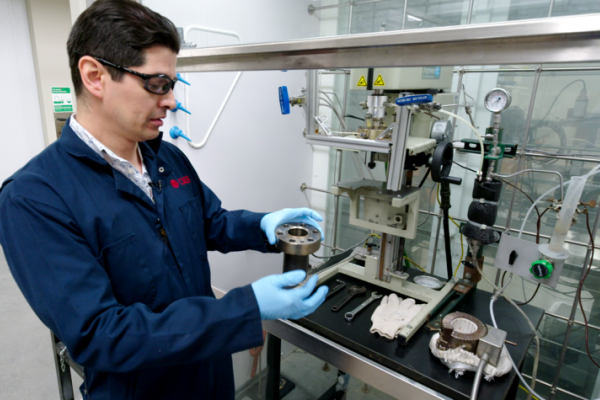As demand for graphite grows, UK CAER positioned to lead material sourcing

Materials play a pivotal role in the future of both Kentucky and the nation’s economy. They drive the development of new products and processes in vital industries like health care, electronics, energy and manufacturing.
Innovation hinges on the right materials to enhance performance, durability and efficiency. Critical minerals and rare earth elements are the building blocks of materials. One increasingly valuable material is graphite.
The University of Kentucky’s Center for Applied Energy Research (CAER) is uniquely positioned to research ways to make the Commonwealth a potential source of graphite thanks to its world-renowned scientists and experts on carbon materials.
The global need for graphite
In late October, China announced it would require export permits for certain graphite products. China is the world’s top graphite producer and exporter, refining more than 90% of the global supply of graphite, which is one of the 50 critical minerals listed by the United States Geological Survey (USGS).
This news comes on the heels of a similar announcement earlier this summer regarding gallium and germanium, two rare earth metals that are instrumental in semiconductor manufacturing.
Graphite is a key component in numerous materials in our daily lives — from lubricants to batteries and fuel cells. As the U.S. transitions to renewable energy, graphite will play an increasingly more prominent role. Graphite is a key component in lithium-ion batteries, which are found in products ranging from cell phones to electric vehicle (EV) batteries. Graphite also plays an integral role in solar, wind and nuclear power generation.
“Graphite is one of those materials that most Americans don’t think about,” said Matt Weisenberger, associate director of CAER’s carbon materials research group. “But we use graphite or benefit from the usage of graphite every day. It is in our mobile phones, computers and personal electronic devices.”
Domestic graphite production and growing demand for EVs
According to USGS Research Geologist Jeffrey Mauk, the U.S. has not mined graphite since the 1950s. “In 2021, the U.S. relied on foreign sources for 100% of the 53,000 metric tons of graphite it used. Primary import sources were China, Mexico and Canada,” according to Mauk’s report.
Graphite comes from two sources: mining of natural flake graphite and synthetic production, derived from petroleum or coal-derived coke and pitch. No matter the source, the overwhelming majority of graphite used worldwide is produced in Asia. Seventy-six percent of natural flake graphite and 81% of synthetic graphite comes from Asia.
According to Julian Norley of Norley Carbon and Graphite Consultants, the global demand for graphite is on the rise, driven — in large measure — by an increasingly robust EV market.
In 2023, a Benchmark Minerals report showed that China will account for 92% of anode-grade graphite production globally, Norley said. Though this forecast is projected to decrease over the rest of the decade, China is expected to account for more than 80% of anode production in 2030.
The U.S. government has recognized this issue, funding domestic graphite production. In October 2022, the U.S. Department of Energy — as part of the bipartisan infrastructure law – awarded $486 million to three graphite projects that will produce about 110,000 metric tons per year of anode-grade material. But, as Norley points out, more is needed, particularly in light of the recently announced export permits from China.
“It is difficult to overstate how important graphite is to our EV market,” said Norley. “Graphite accounts for nearly 50% of the weight needed for EV batteries. An average electric vehicle contains 175 pounds of graphite. There is no other way to say it: As the U.S. EV market continues to grow, we will need hundreds of thousands of tons of graphite.”
In 2022, 918,500 EVs were sold in the U.S., according to Statista. The country’s EV market is primed for unprecedented growth. In 2022 alone, automobile companies announced a record $73 billion in planned EV projects. In Glendale, Kentucky, Ford and BlueOval SK are building a $5.8 billion plant that will construct batteries for Ford and Lincoln EVs.
“Finding new, sustainable domestic sources of graphite is mission critical to the American economy,” Norley said. “The surest way of discovering those sources is through research and development.”
An internationally known carbon materials program in the heart of the Bluegrass
CAER is home to one of the nation’s largest and most comprehensive carbon materials research and development programs. For more than two decades, the center has become internationally recognized for its innovative research in carbon materials — from carbon fiber and foams to graphite. Most recently, CAER has been focused on developing new sources of graphite from Kentucky waste coal.
“Our policymakers and federal funding agency partners have made clear over the past decade the need to identify domestic sources of critical minerals and rare earth elements,” said Rodney Andrews, CAER director and one of the nation’s leading carbon materials researchers. “We have developed programs, research expertise and processes to extract and purify those minerals – including graphite – from domestic sources.”
CAER’s research expertise in this area stands at the convergence of two of the university’s research priority initiatives, which challenge Kentucky’s top researchers to focus on the Commonwealth’s most pressing issues. The university’s Energy Research Priority Area and recently created Materials Science Research Priority Area seek to find innovative solutions to address industry challenges and position the Commonwealth to become a global leader in a competitive materials market.
More from this series Research Priorities - Energy
Credits
Words: David Melanson (Center for Applied Energy Research)
Photos: Jeremy Blackburn (Research Communication)


